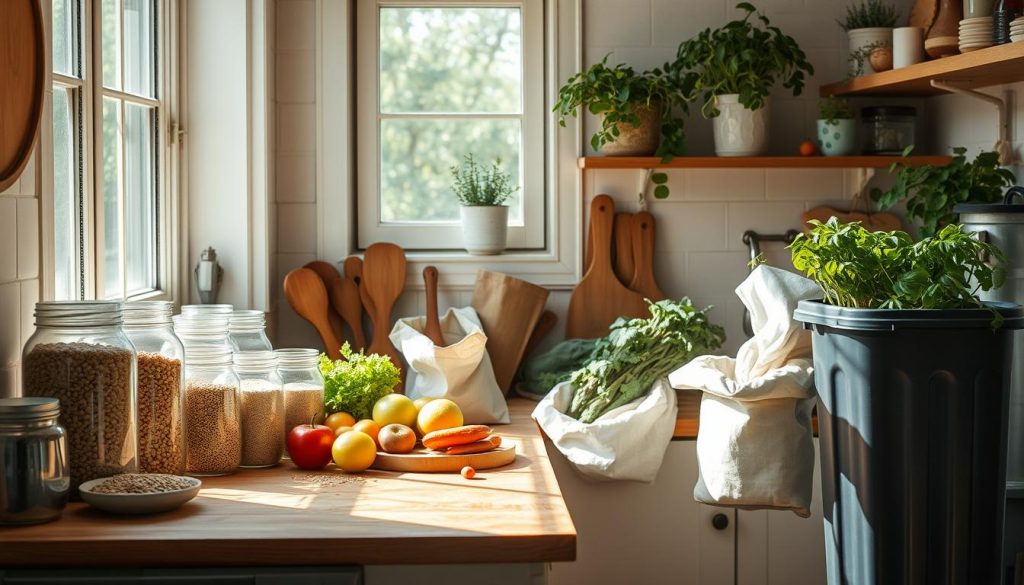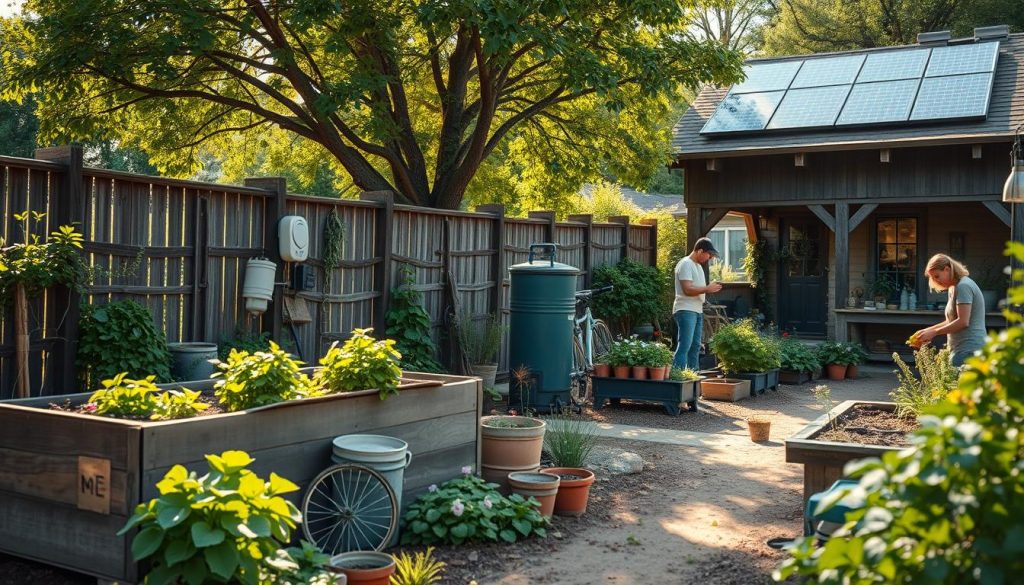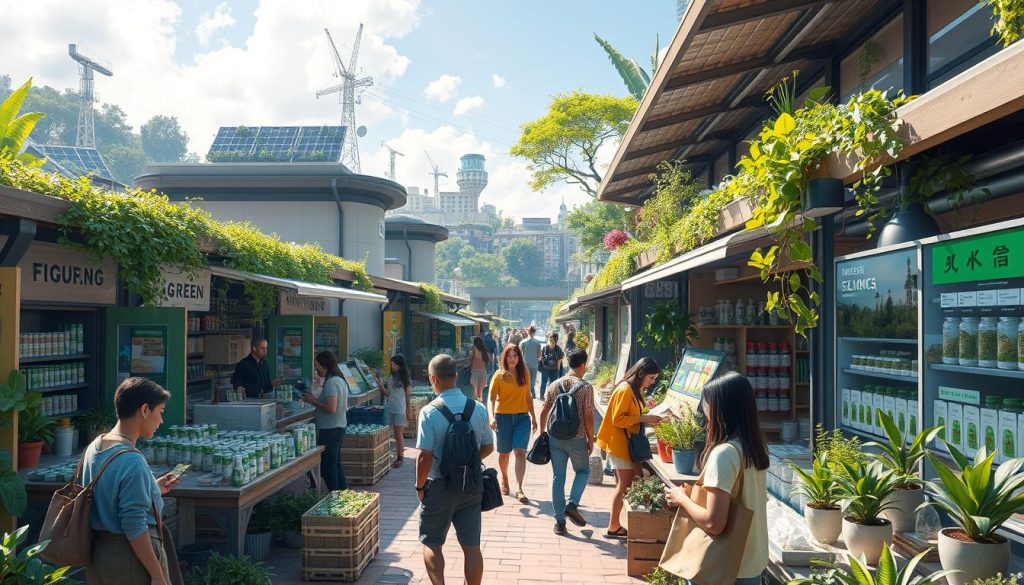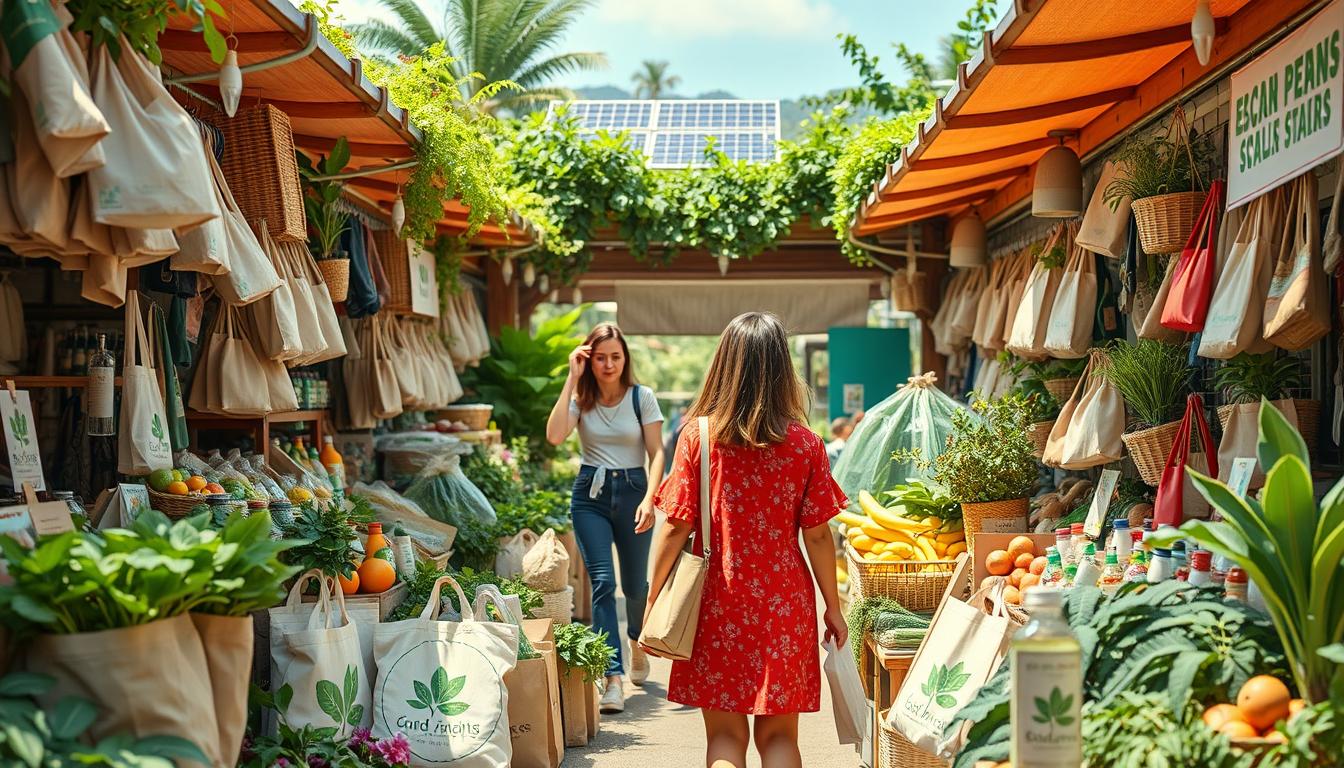I’ve seen a big change in how we shop. It’s called eco-conscious consumerism. It’s about choosing things that are good for our planet. Learning about sustainable consumption has shown me how our daily buys affect the environment.
By thinking about what we buy, we can lessen our harm to the planet. Every choice we make, from clothes to food, matters. In this article, I’ll show how we can shop smart and green. And why it’s important for our future.
Want to start this green journey with me? Let’s explore how our shopping can help make our world more sustainable.
Understanding Eco-conscious Consumerism
Eco-conscious consumerism is changing how we shop and live. It’s about making choices that help our planet and society. Sustainable consumption means buying products that don’t harm the environment much.
Defining Sustainable Consumption
Sustainable consumption is about buying less and choosing quality over quantity. It’s also about picking products made from renewable resources. We should think about a product’s whole life cycle, from making it to throwing it away.
The Role of Consumers in Driving Change
As consumers, we can influence market trends. By supporting eco-friendly brands and products, we tell companies what we value. This pushes more businesses to be more sustainable.
Environmental and Social Impacts of Consumer Choices
Our buying decisions affect the world a lot. Choosing sustainable products can cut pollution, save resources, and support fair labor. Here’s how our choices impact the world:
| Consumer Choice | Environmental Impact | Social Impact |
|---|---|---|
| Buying local produce | Reduces transport emissions | Supports local farmers |
| Choosing organic products | Decreases pesticide use | Improves farm worker health |
| Opting for reusable items | Reduces plastic waste | Creates demand for sustainable jobs |
By embracing eco-conscious consumerism, we can make a positive difference. Every purchase is a vote for the world we want to live in.
The Power of Green Products
Green products are changing how we shop and live. I’ve seen a big increase in eco-friendly brands. They offer sustainable choices for everyday items.
- Home cleaning supplies
- Personal care items
- Reusable containers and bags
- Energy-efficient appliances
- Organic food and beverages
Choosing these eco-friendly options helps the planet. For example, reusable bags cut down on plastic waste. Energy-efficient appliances also save money and reduce carbon emissions.
Many green products use recycled or renewable materials. This saves natural resources and reduces landfill waste. Some brands even use special packaging to lessen their environmental impact.
| Product Category | Environmental Benefit | Personal Benefit |
|---|---|---|
| Reusable Water Bottles | Reduces plastic waste | Saves money on bottled water |
| LED Light Bulbs | Lowers energy consumption | Reduces electricity bills |
| Natural Cleaning Products | Fewer harmful chemicals released | Safer for household use |
As more people want sustainable choices, eco-friendly brands keep innovating. This move towards green products is making the market more sustainable.
Navigating Ethical Shopping Practices
Ethical shopping can change the world. My choices help support sustainable businesses. Let’s learn how to shop better.
Researching Brand Values and Practices
I research a company’s values before buying. I check their website, read reviews, and look at their supply chain. Companies that care about fair labor and the environment usually share this info.
Understanding Certifications and Labels
Certifications and labels help in ethical shopping. I look for symbols like Fair Trade, USDA Organic, or B Corp. These show a company’s commitment to being responsible. Knowing what these mean helps me make better choices.
Supporting Local and Sustainable Businesses
Supporting local and sustainable businesses is great. It cuts down on emissions and helps our community. I enjoy shopping at farmers’ markets, local shops, and eco-friendly stores. They offer unique products and care about the planet.
By following these practices, we can make a big difference. Every purchase is a vote for the world we want. Let’s use our power to support businesses that share our values and help the planet.
Reducing Your Carbon Footprint Through Smart Choices
Every small action we take can help reduce our carbon footprint. By making smart choices every day, we can help create a more sustainable world. Let’s look at some easy ways to live more consciously and lower our environmental impact.
Transportation is a big source of carbon emissions. I’ve found that using public transit, carpooling, or biking helps a lot. It not only cuts down on carbon but also saves money. When I do have to drive, I choose cars that use less fuel or electric cars to reduce emissions.
At home, we can also make a difference. I’ve switched to LED bulbs and energy-saving appliances, which has cut down my electricity use. Using a programmable thermostat helps me save even more by optimizing heating and cooling.
What we eat is also important. I’ve started eating more plant-based meals, as they tend to have a lower carbon footprint. Buying local and seasonal produce helps reduce emissions from transportation and supports local farmers. I also try to waste less food by planning meals and composting.
- Use reusable bags, water bottles, and containers
- Choose products with minimal packaging
- Repair items instead of replacing them
- Opt for digital subscriptions over print
By making these changes, I’ve greatly reduced my carbon footprint. Every eco-friendly choice we make brings us closer to a greener future. Remember, it’s all about making progress, not being perfect.
Embracing the Circular Economy
The circular economy is changing how we think about using things and waste. It’s a system that aims to eliminate waste and make the most of our resources. I’ve learned that this approach can help us create a more sustainable future.
Understanding the Concept of Circular Economy
In a circular economy, we move away from the “take-make-waste” model. Instead, we focus on reusing, repairing, and recycling products. This helps reduce waste and conserves resources. By adopting this mindset, we can significantly decrease our environmental impact.
Participating in Product Lifecycle Extension
I’ve found several ways to extend the life of products:
- Repair items instead of replacing them
- Donate or sell usable goods
- Upcycle old items into new, useful objects
- Choose durable, long-lasting products
These actions help keep items in use longer, reducing waste and supporting the circular economy.
Supporting Businesses with Circular Models
Many companies are adopting circular economy principles. I make an effort to support these businesses by:
- Choosing products made from recycled materials
- Using rental or sharing services
- Buying from companies with take-back programs
By supporting these businesses, I encourage more companies to adopt circular models, moving us closer to a zero waste future.
| Traditional Economy | Circular Economy |
|---|---|
| Single-use products | Reusable and recyclable products |
| Landfill disposal | Resource recovery and recycling |
| Planned obsolescence | Design for longevity and repair |
Zero Waste Lifestyle: A Path to Eco-conscious Consumerism

I’ve found that living zero waste is a great way to be more eco-friendly. It’s not just about recycling. It’s about changing how we make choices every day to help the planet.
Living zero waste means not throwing anything away. We need to think differently about shopping and find new ways to reuse and recycle. Here are some tips that have helped me:
- Bring reusable bags, containers, and water bottles when shopping
- Choose products with minimal or no packaging
- Buy in bulk to reduce packaging waste
- Opt for secondhand items when possible
- Compost food scraps and yard waste
Dealing with food waste was a big challenge for me. I started planning meals and saving leftovers. This cut down on waste and saved money too. It shows how small actions can have a big impact on our planet.
Changing to a zero waste lifestyle takes time and effort. I’ve found it helpful to tackle one area at a time, like the bathroom or kitchen. The goal is to make progress, not to be perfect. It’s about moving towards better habits for our planet.
| Area | Zero Waste Alternative | Environmental Impact |
|---|---|---|
| Kitchen | Reusable cloth napkins | Reduces paper waste |
| Bathroom | Bamboo toothbrush | Biodegradable alternative to plastic |
| Cleaning | DIY all-purpose cleaner | Eliminates plastic bottles and harsh chemicals |
| Shopping | Reusable produce bags | Reduces single-use plastic consumption |
Top Eco-friendly Brands Making a Difference
I’m always searching for eco-friendly brands that lead in sustainability. These companies show that green products can be stylish and good for the planet. Let’s look at some top brands in different categories.
Clothing and Fashion
In fashion, Patagonia is a leader in sustainability. They use recycled materials and offer repair services. Everlane is also notable for its transparent supply chain and ethical manufacturing.
Home Goods and Furniture
For home furnishings, I choose West Elm. They have sustainable furniture made from FSC-certified wood. Avocado Green Mattress is another favorite, offering organic mattresses and bedding.
Personal Care and Cosmetics
Lush Cosmetics is a top choice for personal care with their package-free products. Beautycounter is also making a difference in cosmetics with clean beauty products and advocacy for better regulations.
| Category | Brand | Eco-friendly Features |
|---|---|---|
| Fashion | Patagonia | Recycled materials, repair services |
| Home Goods | West Elm | FSC-certified wood furniture |
| Personal Care | Lush Cosmetics | Package-free products, natural ingredients |
These eco-friendly brands are just a few examples of companies making a real difference. By supporting these green products, we can encourage more businesses to be sustainable. This helps make our planet healthier.
Conscious Living: Beyond Shopping

Conscious living is more than just shopping. It’s about living a life that thinks about the planet in every choice. As I’ve learned more about eco-friendly shopping, I’ve seen that real change comes from changing how we think.
I’ve started living more simply by owning less. This has cut down my use of resources and made me happier with life’s moments, not just things. It’s not only better for the planet but also clears my mind.
Doing things myself has become a big part of my green lifestyle. I make my own cleaners and fix up old furniture. It saves money and makes me feel proud of what I can do.
Being part of my community has helped me even more. I’ve joined in on beach cleanups and planted trees. It’s not just about helping the planet; it’s also about meeting people who share my values.
- Embrace minimalism to reduce consumption
- Explore DIY projects to avoid unnecessary purchases
- Participate in community environmental initiatives
- Focus on experiences over material possessions
By living this way, conscious living becomes easy. It’s a path of learning and growing, but it’s rewarding to know I’m helping the planet with every choice.
Measuring and Minimizing Environmental Impact
Understanding our habits is the first step to controlling our environmental impact. Tracking my carbon footprint helps me make better lifestyle choices.
Tools for Tracking Personal Environmental Impact
Online calculators and apps make tracking your carbon footprint easy. They look at energy use, transportation, and diet. My top pick is the EPA’s Carbon Footprint Calculator, which gives a detailed breakdown of emissions.
Setting Goals for Reduction
After finding out my baseline, I set realistic goals to lessen my impact. I began by aiming to use 10% less energy in the first month. Setting goals helped me stay on track and see my progress.
Celebrating Progress and Inspiring Others
Sharing my journey has been rewarding. I celebrate small victories on social media, which often starts conversations about eco-friendly living. By sharing tips and experiences, we encourage each other to make positive changes.
| Action | Environmental Impact Reduction |
|---|---|
| Switch to LED bulbs | 75% less energy use |
| Use public transport | 20% lower carbon emissions |
| Eat plant-based meals | 50% reduced food-related emissions |
In just six months, I’ve cut my carbon footprint by 30%. It’s incredible how small changes can make a big difference for our planet.
The Future of Green Consumerism

I see a bright future for eco-conscious consumerism. The green marketplace is growing fast, thanks to new tech and changing habits. Now, sustainable living is a big deal, changing how industries work.
Smart, connected products are leading the way. They help us use less energy and water easily. I’m really excited about how IoT tech can change our lives for the better.
Plant-based and lab-grown products are also making a big splash. They offer green choices for food, clothes, and more. As they get cheaper and more common, they’ll change what we buy and how we live.
Blockchain tech is going to make things even clearer. It will let us know more about what we buy. This could make us all more responsible in our choices.
| Trend | Impact on Eco-conscious Consumerism |
|---|---|
| Smart, connected products | Optimize resource use, reduce environmental footprint |
| Plant-based alternatives | Provide sustainable options for various products |
| Blockchain technology | Enhance supply chain transparency, inform consumer choices |
The future of green consumerism is looking good. With these trends, I think we’ll see a big move towards greener choices. This will be good for us and the planet.
Conclusion: Your Role in Shaping a Sustainable Future
As we finish our look at eco-conscious consumerism, I hope you’ve learned a lot. Every time we buy something, it affects the environment. It’s our job to make sure it’s for the better. By choosing sustainable options, we can make a big difference.
Eco-conscious consumerism is more than just buying green. It’s about thinking about the whole life of what we buy. By supporting the circular economy and cutting down on waste, we help the planet. Your efforts to learn about brands, understand labels, and shop local are key to a greener future.
I urge you to keep going on your eco-friendly path. Set goals to lessen your environmental footprint and see how you do. Tell your loved ones about your journey, encouraging them to join in. Together, we can change how people shop and push companies to be more eco-friendly. Your decisions are crucial and are helping make our planet healthier for all.
